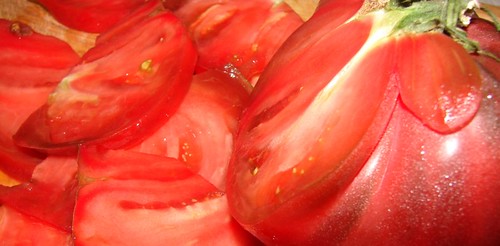 Early July always drives me crazy. My tomato plants are doing great but we're still three weeks out from being able to actually pick anything, and the farm stands have nothing but hothouse tomatoes that are just a step or so up from the same watery bland "winter tomatoes" that I boycott anyway.
Early July always drives me crazy. My tomato plants are doing great but we're still three weeks out from being able to actually pick anything, and the farm stands have nothing but hothouse tomatoes that are just a step or so up from the same watery bland "winter tomatoes" that I boycott anyway.So it was a real surprise to me when I saw this huge, half-pound purple-tinted heirloom tomato at the supermarket the other day. It was the size of a garden-raised Beefsteak tomato with a blackish-purple blush to its skin. A gentle squeeze revealed it to be at just the right stage of ripeness, and it passed my best indicator of true worth: it smelled like a fresh-picked sun-ripened back yard tomato.
You can see from the picture above what I found when I sliced into this beauty. I can't believe how meaty it was - there were hardly any seeds at all, just firm ripe tomato bursting with sweet and tangy summer flavor. The near-seedlessness really intrigued me, because I grow six or eight different varieties of tomatoes every year and I've never found one yet that gave me a fruit with so few seeds. That's important to me because my daughter loves tomatoes but doesn't care for the icky mouthfeel of what she calls "the tomato guck." I decided that I'm going to save the seeds from this fruit and try to grow them next season. I'm trusting the label on the fruit calling it an "heirloom" tomato, which means it should reproduce true from a seed, but i don't know what variety it is or if it has a name.
By the way, it turned out that this tomato is a Sunset brand tomato, from the same Ontario hydroponics company that I have written about twice before - Mastronardi Produce Ltd. I guess I shouldn't be surprised at the quality of this one, given how good their other stuff has been.
Whenever I find a variety of tomato I really like, whether it's at a grocery store, farmers market, or roadside stand, I save some of the seeds to try out in my garden. Most of the time I have pretty good results with saved seeds. There is a bit of commitment involved in saving tomato seeds, but it isn't that difficult.
- Scoop out the seedy pulp with a spoon or your finger, and put it goo and all into a small glass container like a jar or a juice glass. Something small.
- Add some water to the seeds and swish them around a little.
- Cover the top of the glass with some plastic wrap. Poke a few holes in the plastic to let some air in.
- Put the glass in a warm place, like a window sill. It will ferment after a day or two. This is what you want. Fermentation gets rid of the goo and frees the seed. It also helps kill off any seed-borne illness that might be lurking in your tomato plant.
- Every night while you're waiting for the fermentation, take off the plastic wrap and give the seed liquid a gentle stir. Soon you'll notice some foamy scum at the top of the glass. You're ready to take out your seeds.
- With a spoon, skim off the scum at the top of the glass. Don't worry about any seeds that are in the scum, you can throw then away as well because they're dead.
- Pour the liquid through a fine-mesh kitchen strainer and rinse with cool running water, swishing the seeds around gently, to remove any remaining traces of the goo. Put the seeds on some mesh or screening or a paper coffee filter to completely drain and air-dry. It will take a couple of days, during which time you should stir them around a little and keep them in a single layer so they dry evenly.
- When they're completely dry, put them away in a paper envelope in a cool dark place until early spring when you can start them indoors.
.

great idea to save seeds! though i'm not so good with starting plants by seed - I'm a sorta-gardener w/my 5 Earthboxes
ReplyDeleteI am always jealous of people with gardens. Living in a New York apartment is sometime frustrating in the summer, when people in other parts of the country can grow their own fresh produce.
ReplyDeleteI love heirloom tomatoes if they are the real thing. They are so much more flavorful and meaty. I love to just douse them with balsamic vinegar, olive oil, and sprinkle with salt and pepper. A few sprigs of basil round out the flavor. Yum!
These are great tips! I unwittingly started a tomato plant in my compost pile last month. Apparently, the pile was not getting hot enough to compost, but the growing conditions were just right for the seeds of an heirloom tomato that I tossed in. The plant is now happily growing in a container. I'm looking forward to the fruit!
ReplyDelete